154 scholarly books by Diaphanes and 7
have author last names that start with K
154 scholarly books by Diaphanes and 7
154 scholarly books by Diaphanes
7 have author last names that start with K have author last names that start with K
7 have author last names that start with K have author last names that start with K
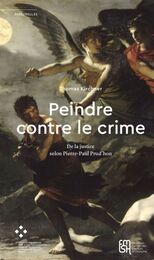
Peindre contre le crime
Thomas Kirchner
Diaphanes, 2020
Peint en 1808 pour une salle d’audience du Palais de Justice de Paris, le tableau de Pierre-Paul Prud’hon La Justice et la Vengeance divine poursuivant le Crime a toujours été considéré comme un chef-d’œuvre du romantisme français, mais rarement étudié sous l’angle de l’histoire du droit pénal. Pourtant, les débats contemporains autour de la question du libre arbitre jouèrent un rôle fondamental dans le choix de son iconographie. Selon la conception invoquée par Prud’hon, l’homme agissant librement est pleinement responsable de ses actes, y compris de ses crimes, responsabilité qui confère au législateur le droit moral de fixer des sanctions, même sévères. Les réflexions d’Emmanuel Kant revêtent dans ce contexte une importance majeure. Prud’hon en eut probablement connaissance par l’intermédiaire du commanditaire du tableau, le préfet du département de la Seine Nicolas-Thérèse-Benoît Frochot, auquel est attribuée ici la paternité du programme iconographique. À travers la présente monographie, Thomas Kirchner montre combien cette célèbre peinture est l’exact reflet des discussions juridiques et philosophiques qui animèrent la France révolutionnaire, et donnèrent naissance au nouveau Code pénal et à un nouveau Code d’instruction criminelle.
[more]
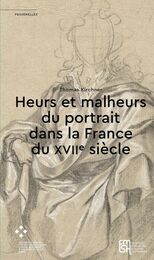
Heurs et malheurs du portrait dans la France du XVIIe siècle
Thomas Kirchner
Diaphanes, 2022
Le portrait est sans conteste le genre artistique le plus fécond du début des Temps modernes. Dans la France du XVIIe siècle, qui se distingue par une mobilité sociale inconnue jusqu’alors, le portrait permet précisément d’appuyer la revendication d’un nouveau statut social ou d’assurer un rang acquis, mais désormais remis en question. Le portrait se fait également l’écho de la discussion capitale concernant le rapport entre le corps et l’âme. Pourtant, les sources écrites parvenues jusqu’à nous, qui s’intéressent au portrait, sont étonnamment parcimonieuses. L’Académie royale de peinture et de sculpture fondée en 1648, en particulier, est presque totalement muette à ce sujet. Et ce, bien que nombre de ses membres gagnent leur vie comme portraitistes et que le genre voie son importance s’accroître au cours du Grand Siècle : les portraits se multiplient, tandis que leur prix augmente constamment. Il semble que l’Académie ait sciemment passé sous silence le portrait et les débats afférents, afin de mieux célébrer comme sa véritable mission la peinture d’histoire, sur laquelle l’institution nous a laissé d’innombrables témoignages.
La présente étude reconstitue les discours autour du portrait dans la France du XVIIe siècle et dévoile une discussion d’une vivacité surprenante, où d’aucuns se sont même demandé si le portrait ne méritait pas – plutôt que la peinture d’histoire – d’occuper la première place dans la hiérarchie des genres.
La présente étude reconstitue les discours autour du portrait dans la France du XVIIe siècle et dévoile une discussion d’une vivacité surprenante, où d’aucuns se sont même demandé si le portrait ne méritait pas – plutôt que la peinture d’histoire – d’occuper la première place dans la hiérarchie des genres.
[more]
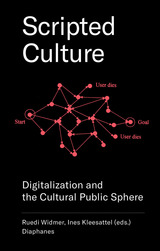
Scripted Culture
Digitalization and the Cultural Public Sphere
Ines Kleesattel
Diaphanes, 2018
When we look at the cultural public sphere through the lens of digitalization, a paradoxical picture emerges. In some ways, the digital age seems to have brought the goals of the Enlightenment to their fullest fruition, giving us boundless and instantaneous access to every kind of knowledge and art. But the internet and its platforms also frequently bring chaos, immersing us in a sphere of often unverified information whose scope is unimaginable. This book takes a tour through the current debates on digital culture, bringing together a wide array of perspectives from aesthetic theory, cultural studies, electronic media, and the arts.
[more]
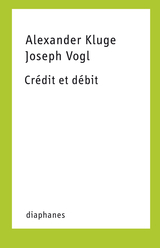
Crédit et débit
Alexander Kluge
Diaphanes, 2013
Les chaînes privées allemandes ne sont pas vraiment réputées pour le niveau élevé des débats qu’elles diffusent; la surprise est d’autant plus grande pour le zappeur qui, aux alentours de minuit, tombe sur ce genre de phrases : « La superstition économique est un peu comme l’éventail des vertus bourgeoises » ou « Les solutions se trouvent toujours dans la rue, dans le trafic. » Aucun doute : il s’agit d’une des émissions culturelles les plus remarquables – au sens plein du mot – d’Alexander Kluge. Kluge a trouvé en Joseph Vogl un partenaire idéal pour sa technique d’interview si caractéristique. Le résultat de cette passion commune, ce sont plus de 40 interviews télévisuelles qui renouvellent le genre en profondeur. La digression, maniée avec un talent particulier, n’y est jamais gratuite.
[more]
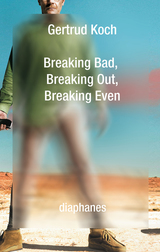
Breaking Bad, Breaking Out, Breaking Even
Gertrud Koch
Diaphanes, 2017
Breaking Bad is known for its grim and gritty outbursts of anger and violence. In the chaotic story of a meth-dealing high school chemistry teacher, time seems to collapse, and we feel as though the lives of the characters are moving inevitably closer to their ends. This warped perspective wends its way through virtually every aspect of the story, intensifying the meaning we attach to the characters’ precarious lives.
Hoping to cultivate a deeper understanding of the series, Breaking Bad, Breaking Out, Breaking Even offers a new way of approaching the program though its complex treatment of time. With its grotesque portrayal of life on the brink of death, argues Gertrud Koch, we can best view Breaking Bad as a black comedy between Chaplin’s Monsieur Verdoux and film noir. Koch takes readers through the ways in which this is accomplished through the show’s various visual elements and masterful temporal and narrative structuring. Full of fascinating insights, the book will appeal to the show’s many fans, as well as anyone interested in film studies, media studies, or popular culture.
Hoping to cultivate a deeper understanding of the series, Breaking Bad, Breaking Out, Breaking Even offers a new way of approaching the program though its complex treatment of time. With its grotesque portrayal of life on the brink of death, argues Gertrud Koch, we can best view Breaking Bad as a black comedy between Chaplin’s Monsieur Verdoux and film noir. Koch takes readers through the ways in which this is accomplished through the show’s various visual elements and masterful temporal and narrative structuring. Full of fascinating insights, the book will appeal to the show’s many fans, as well as anyone interested in film studies, media studies, or popular culture.
[more]
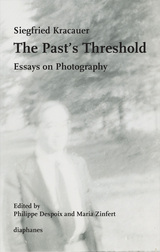
The Past's Threshold
Essays on Photography
Siegfried Kracauer
Diaphanes, 2014
Siegfried Kracauer was a leading intellectual figure of the Weimar Republic and one of the foremost representatives of critical theory. Best known for a wealth of writings on sociology and film theory, his influence is felt in the work of many of the period’s preeminent thinkers, including his friends, the critic Walter Benjamin, and Theodor W. Adorno, who once claimed he owed more to Kracauer than any other contemporary.
This volume brings together for the first time all of Kracauer’s essays on photography that he wrote between 1927 and 1933 as a journalist for the Frankfurter Zeitung, as well as an essay that appeared in the Magazine of Art after his exile in America, where he would spend the last twenty-five years of his life. The texts show Kracauer as a pioneering thinker of the photographic medium in addition to the important historian, and theorist, of film that he is acknowledged to have been. His writings here build a cohesive theory on the affinities between photography, memory and history.
With a foreword by Philippe Despoix offering insights into Kracauer’s theories and the historical context, and a Curriculum vitae in pictures, photographs from the Kracauer estate annotated by Maria Zinfert.
This volume brings together for the first time all of Kracauer’s essays on photography that he wrote between 1927 and 1933 as a journalist for the Frankfurter Zeitung, as well as an essay that appeared in the Magazine of Art after his exile in America, where he would spend the last twenty-five years of his life. The texts show Kracauer as a pioneering thinker of the photographic medium in addition to the important historian, and theorist, of film that he is acknowledged to have been. His writings here build a cohesive theory on the affinities between photography, memory and history.
With a foreword by Philippe Despoix offering insights into Kracauer’s theories and the historical context, and a Curriculum vitae in pictures, photographs from the Kracauer estate annotated by Maria Zinfert.
[more]
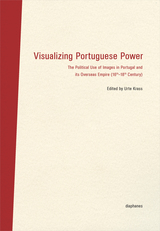
Visualizing Portuguese Power
The Political Use of Images in Portugal and its Overseas Empire (16th-18th Century)
Urte Krass
Diaphanes, 2015
Images play a key role in political communication and the ways we come to understand the power structures that shape society. Nowhere is this more evident than in the process of empire building, in which visual language has long been a highly effective means of overpowering another culture with one’s own values and beliefs.
With Visualizing Portuguese Power, Urte Krass and a group of contributors examine the visual arts within the Portuguese empire between the sixteenth and eighteenth centuries. With a focus on the political appropriation of Portuguese-Christian art within the colonies, the book looks at how these and other objects could be staged to generate new layers of meaning. Beyond religious images, the book shows that the appropriation of the visual arts to reinforce important political concepts also took place in the outside the religious sphere, including adaptations of local artistic customs to reinforce Portuguese power.
With Visualizing Portuguese Power, Urte Krass and a group of contributors examine the visual arts within the Portuguese empire between the sixteenth and eighteenth centuries. With a focus on the political appropriation of Portuguese-Christian art within the colonies, the book looks at how these and other objects could be staged to generate new layers of meaning. Beyond religious images, the book shows that the appropriation of the visual arts to reinforce important political concepts also took place in the outside the religious sphere, including adaptations of local artistic customs to reinforce Portuguese power.
[more]
READERS
Browse our collection.
PUBLISHERS
See BiblioVault's publisher services.
STUDENT SERVICES
Files for college accessibility offices.
UChicago Accessibility Resources
home | accessibility | search | about | contact us
BiblioVault ® 2001 - 2024
The University of Chicago Press









